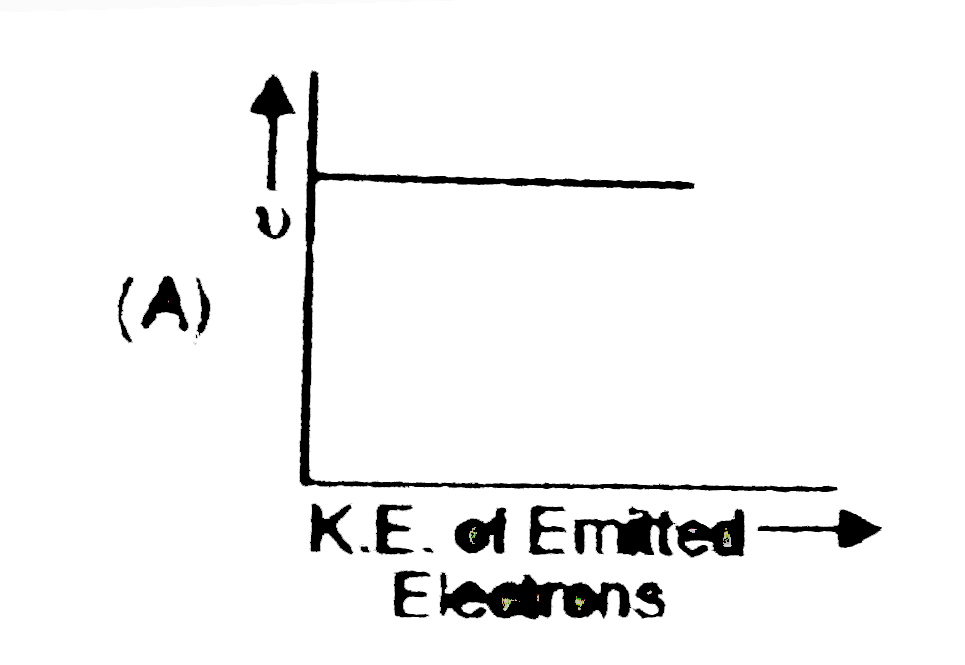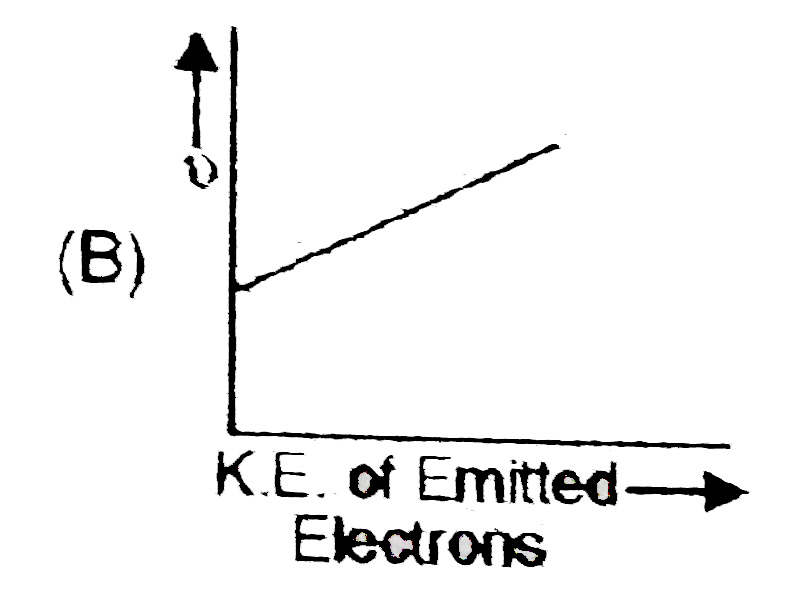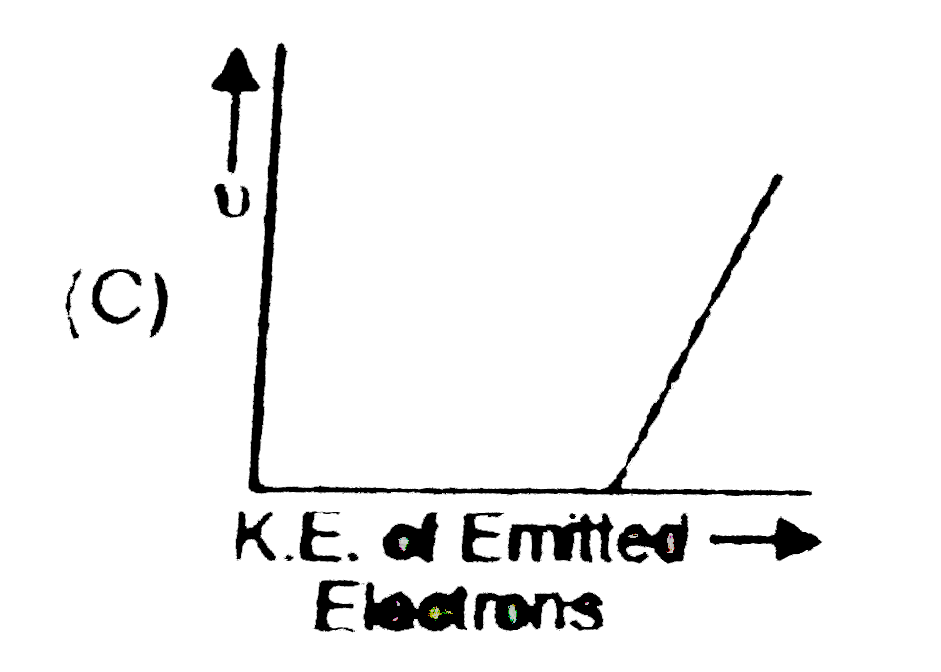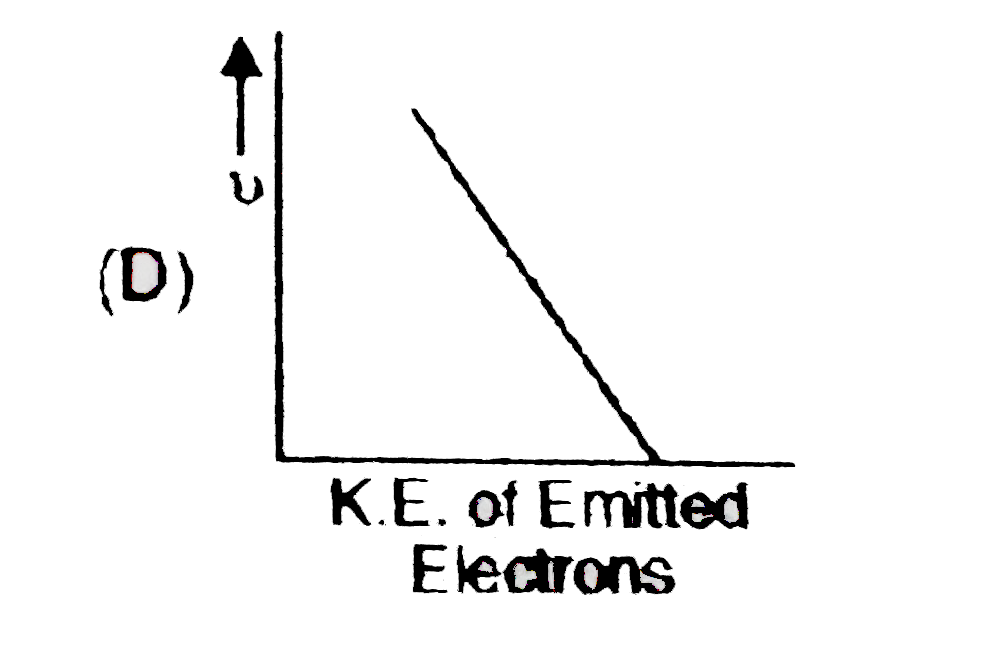Which among the following graphs explains the photoelectric effect?




The correct Answer is:B
To determine which graph explains the photoelectric effect, we will analyze the relationship between the kinetic energy of emitted electrons and the frequency of the incident light.
1. Understanding the Photoelectric Effect:
The photoelectric effect occurs when light shines on a material and causes the emission of electrons. The energy of the incident photons is given by the equation:
E=hν
where E is the energy of the photon, h is Planck's constant, and ν is the frequency of the light.
2. Kinetic Energy of Emitted Electrons:
The kinetic energy (KE) of the emitted electrons can be expressed as:
KE=hν−hν0
where ν0 is the threshold frequency, the minimum frequency required to emit electrons from the material.
3. Rearranging the Equation:
We can rearrange the equation for kinetic energy:
KE=h(ν−ν0)
This shows that the kinetic energy is directly proportional to the frequency of the incident light minus the threshold frequency.
4. Graphical Representation:
- On the graph, we can plot the kinetic energy (KE) on the x-axis and the frequency (ν) on the y-axis.
- The intercept on the y-axis (when KE = 0) occurs at ν=ν0.
- The slope of the line will be h, which is a constant.
5. Identifying the Correct Graph:
- The correct graph will start at the threshold frequency (ν0) on the x-axis and will have a positive slope.
- This means that the graph should not intersect the x-axis (KE cannot be negative) and should be above the origin.
6. Conclusion:
Based on the analysis, the correct graph that explains the photoelectric effect is the one that starts from the x-axis at ν0 and rises linearly, which corresponds to option B.
Final Answer:
The graph that explains the photoelectric effect is option B.
The photoelectric effect occurs when light shines on a material and causes the emission of electrons. The energy of the incident photons is given by the equation:
E=hν
where E is the energy of the photon, h is Planck's constant, and ν is the frequency of the light.
The kinetic energy (KE) of the emitted electrons can be expressed as:
KE=hν−hν0
where ν0 is the threshold frequency, the minimum frequency required to emit electrons from the material.
We can rearrange the equation for kinetic energy:
KE=h(ν−ν0)
This shows that the kinetic energy is directly proportional to the frequency of the incident light minus the threshold frequency.
- On the graph, we can plot the kinetic energy (KE) on the x-axis and the frequency (ν) on the y-axis.
- The intercept on the y-axis (when KE = 0) occurs at ν=ν0.
- The slope of the line will be h, which is a constant.
- The correct graph will start at the threshold frequency (ν0) on the x-axis and will have a positive slope.
- This means that the graph should not intersect the x-axis (KE cannot be negative) and should be above the origin.
Based on the analysis, the correct graph that explains the photoelectric effect is the one that starts from the x-axis at ν0 and rises linearly, which corresponds to option B.
The graph that explains the photoelectric effect is option B.
Topper's Solved these Questions
- BOOK - DINESH PUBLICATIONCHAPTER - CHEMICAL BONDING AND MOLECULAR STRUCTUREEXERCISE - Brain Teaser-240videos
CHEMICAL BONDING AND MOLECULAR STRUCTURE
- BOOK - DINESH PUBLICATIONCHAPTER - CHEMICAL BONDING AND MOLECULAR STRUCTUREEXERCISE - Unit Test - 120videos
CHEMICAL BONDING AND MOLECULAR STRUCTURE
- BOOK - DINESH PUBLICATIONCHAPTER - CHEMICAL BONDING AND MOLECULAR STRUCTUREEXERCISE - Ultimate Preparatory Package20videos
CHEMICAL BONDING AND MOLECULAR STRUCTURE
- BOOK - DINESH PUBLICATIONCHAPTER - CARBOXYLIC ACIDS EXERCISE - BRAIN STORMING MULTIPLE CHOICE QUESTIONS (MCQS)13videos
CARBOXYLIC ACIDS
- BOOK - DINESH PUBLICATIONCHAPTER - CHEMICAL KINETICSEXERCISE - Additional Numerical Problems For Practice16videos
CHEMICAL KINETICS
Similar Questions
Knowledge Check
- Question 1 - Select One
In photoelectric effect
Alight energy is converted into the heat energyBlight is converted into electric energyClight energy is converted into the sound energyDelectric energy is converted into light energy - Question 2 - Select One or More
In photoelectric effect,
AIn photoelectric current is directly proportional to the intensity of incident light.BK.E.max of ejected electrons is dependent on intensity of radiations.Cthere is no time lag between the incidence of photons and ejection of electronsDAll of these are correct. - Question 3 - Select One
In photoelectric effect,
Athe emission of electron is the result of elastic collision between the incident photon and the electron.Babsorption of photon is a gradual process.Cthe emission of electron is a result of inelastic collision between the photon and the electron.Dat the threshold frequency, the kinetic energy of ejected electrons is maximum.
Why wave theory of light could not explain the photoelectric effect ? State two reasons. Draw graph between anode potential vs photoelectric current .
View SolutionWhich of the following statements about the photoelectric effect, are true
View SolutionWho among the following has explained the phenomenon of photoelectric effect?
View SolutionWhich of the following charaterstics of photoelectric effect supports the particle nature of radiations
View SolutionWhich of the following experiment in Photoelectric effect will support particle nature of light ?
View Solution

